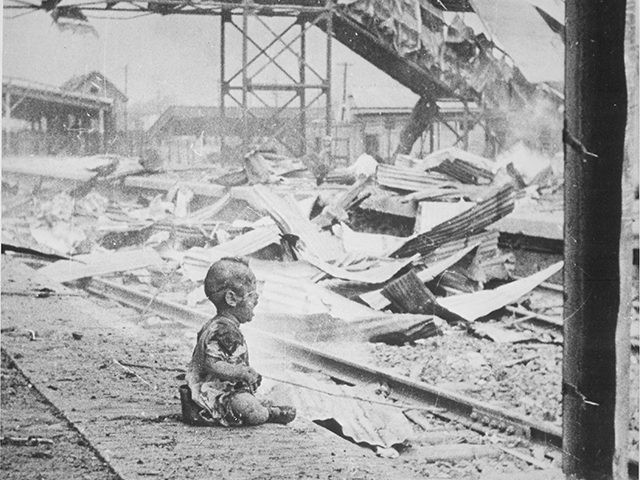President Obama made a single, vague reference to “evil” during his prepared remarks in Hiroshima: “We may not be able to eliminate man’s capacity to do evil, so nations and the alliances that we form must possess the means to defend ourselves. But among those nations like my own that hold nuclear stockpiles, we must have the courage to escape the logic of fear and pursue a world without them.”
He spoke at length about the horrors experienced by the populace of Hiroshima:
We stand here in the middle of this city and force ourselves to imagine the moment the bomb fell. We force ourselves to feel the dread of children confused by what they see. We listen to a silent cry. We remember all the innocents killed across the arc of that terrible war and the wars that came before and the wars that would follow.
Mere words cannot give voice to such suffering. But we have a shared responsibility to look directly into the eye of history and ask what we must do differently to curb such suffering again.
“Let all the souls here rest in peace, for we shall not repeat the evil,” he said, when readingthe inscription on a monument at the Peace Memorial Park.
He somehow forgot to mention the evils perpetrated by Imperial Japan or the unspeakable suffering it inflicted upon POWs and civilians who fell into its clutches.
Let’s correct that oversight, to help the President understand why moral equivalence is the dim refuge of lazy minds, and equating American troops with the Axis forces they defeated is an outrage.
Pearl Harbor
We can start with the one everybody knows about: the sneak attack on Pearl Harbor. That was a war crime, Mr. Obama, as very clearly stated in the relevant international laws of the day. It was accompanied by equally illegal bombings against Singapore, Hong Kong, and the Philippines, as part of a very deliberate Japanese strategy. In Hiroshima, Obama’s sole criticism of the Empire of Japan was some mumbled mush about “mistakes of the past,” and that wasn’t even exclusively directed at the Japanese. Nothing they did was a mistake.
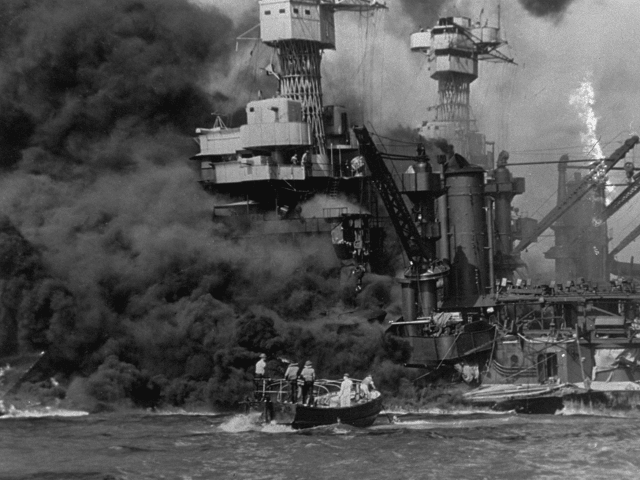
A small boat rescues sailors from the USS ‘West Virginia’ after she had suffered a hit in the Japanese attack on Pearl Harbor. The USS Tennessee (BB-43) is inboard of the sunken battleship. (Photo by Fox Photos/Getty Images)
Mr. Obama, who claims to be a lawyer and devotee of international law, may be interested to know that every single one of the 3,581 casualties at Pearl Harbor (according to theNational WWII Museum tally) were considered non-combatants, including the 2,403 military personnel who were killed, because Japan did not declare war before the attack. If it happened today, it would be rightly denounced as a terrorist attack.
The Bataan Death March
Here’s another one every American school kid should know about: the Bataan Death March. There was no swift death for the thousands of Americans and Filipinos under siege by Japanese forces in the Philippines. They were already sick and starving when they surrendered to the Japanese.
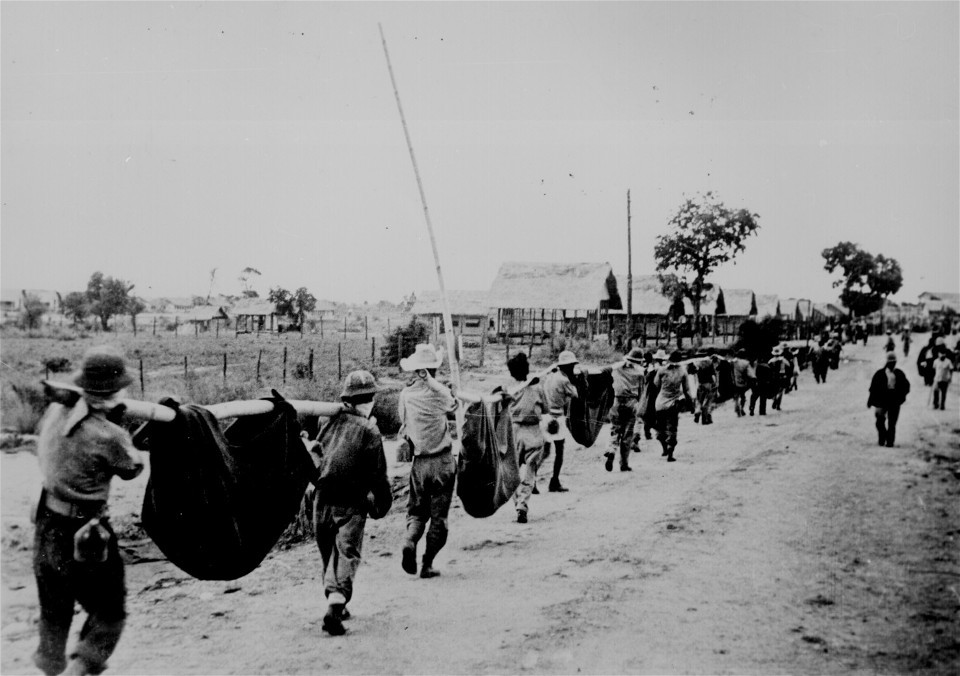
“This picture, captured from the Japanese, shows American prisoners using improvised litters to carry those of their comrades who, from the lack of food or water on the march from Bataan, fell along the road.” Philippines, May 1942. (Wikimedia Commons)
In an act of pure, deliberate sadism, because they were enraged by stiff American resistance during the siege, the Japanese forced their prisoners to march a hundred miles to a prison camp on foot. Many of the prisoners were killed out of hand, including anyone who dared to ask for water… and anyone who collapsed from dehydration. POWs reportedJapanese soldiers taking away their meager supply of water and feeding it to horses while they watched. Starving men were tortured with false offers of food. Prisoners who accepted gifts of food from civilians along the route were murdered.
Some were murdered merely for possessing Japanese items, including currency. They were killed by beheading and run through with bayonets, as well as gunshots. Bayonet victims died from orgies of frenzied stabbing, not clean and swift impalement. Some of the captives were reportedly driven insane by exposure to the sun. They were also crammed into barbed-wire pens were malaria, dengue fever, dysentery, and other diseases ran wild.
It has been estimated that between 5,000 and 11,000 of Japan’s prisoners were killed during the Bataan Death March. That wasn’t the only death march the Empire perpetrated, either. The prisoners of Sandakan were subjected to multiple forced marches, once the Japanese lost interest in using them as slave labor. By the time they were finished, only six of the original 2,390 prisoners were still alive.
One of the Japanese torture methods recounted by survivors of Sandakan involved pouring water down a prisoner’s throat until his stomach became distended, and then kicking him in the stomach.
About half of Japan’s captives in the Pacific died before the end of the war. Brave men who survived the experience spent the rest of their lives refusing to talk about what they went through.
The Rape of Nanking
Citizen of the World Barack Obama doesn’t much care for the idea of “American exceptionalism,” so he might want to consider the atrocities Imperial Japan perpetrated against the people of other countries, too. In Bataan and other POW atrocities, for example, the Japanese were even more brutal toward Filipinos than Americans. China, of course, still remembers the Rape of Nanking.
That was a literal rape, involving up to 80,000 sexual assaults. The once-prosperous city of Nanking, capital of Nationalist China at the time, was laid waste. Japanese conquerors murdered men, women, and children by the thousands, leaving bodies piled up along the streets. The Yangtze River turned red from all the blood.

Bodies of victims along Qinhuai River out of Nanking’s west gate during Nanking Massacre. (Wikimedia Commons)
The death toll ran into the hundreds of thousands, leaving some modern observers to speak of genocide. The exact body count remains a matter of political dispute between Japan and China to this day. The figure generally accepted at post-war trials was over 200,000, but some think the total number is closer to 400,000.
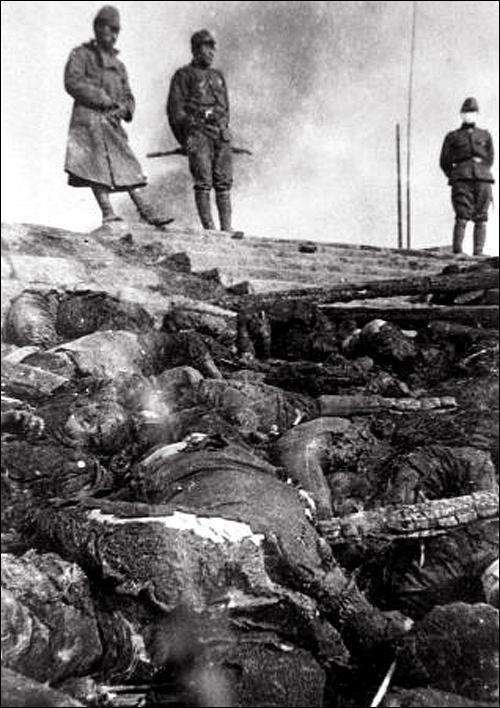
Japanese troops massacred Chinese soldiers and civilians along the Yangtze River and burned the dead. Nanjing, China, 1937. (Wikimedia Commons)
Imperial Japan approached its Chinese foes with the same strategy ISIS uses against its enemies today: maximum carnage and savagery, to terrorize the foe into submission. They used some of the exact same methods ISIS does, including burning captives alive, beheading them, and burying them alive in slaughter pits.
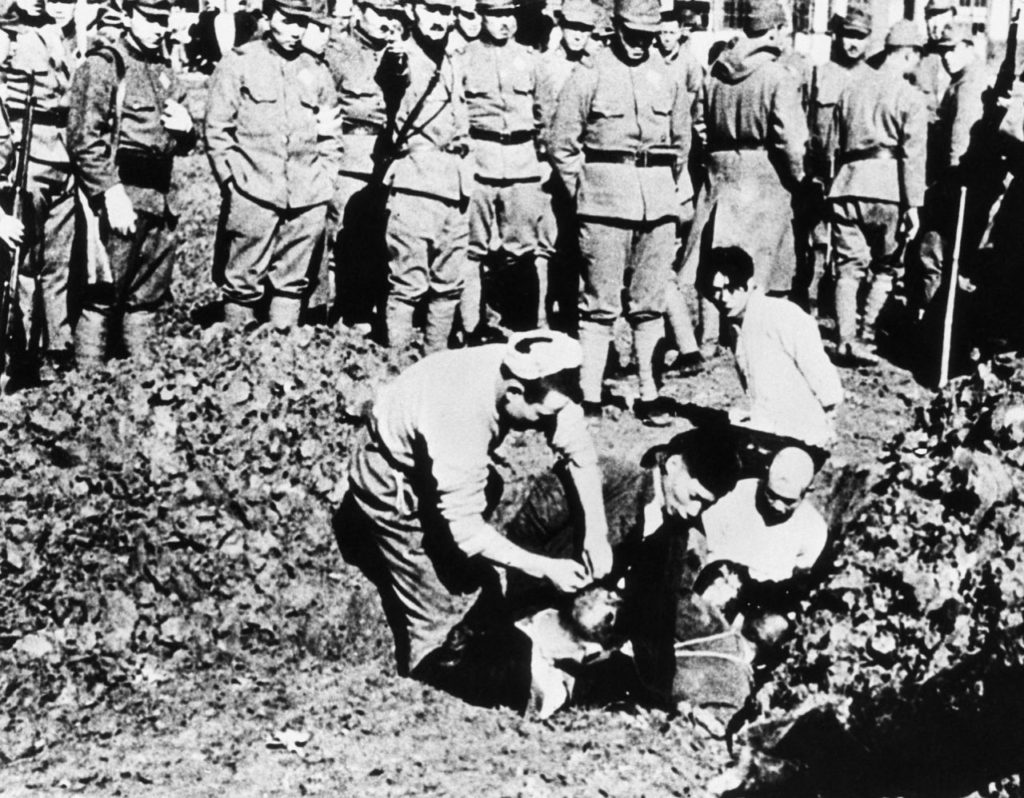
Chinese prisoners being buried alive by their Japanese captors outside the city of Nanking, November 1938.
http://www.breitbart.com/national-security/2016/05/27/war-crimes-imperial-japan-lesson-moral-equivalence-mr-obama/
